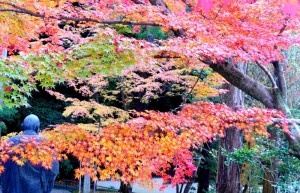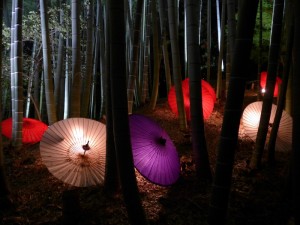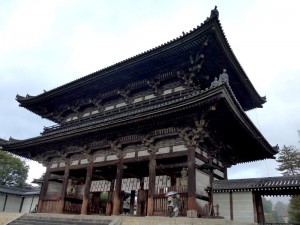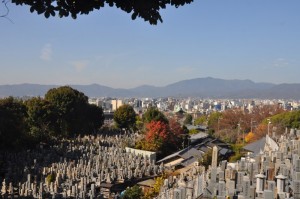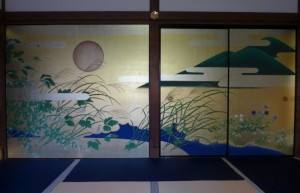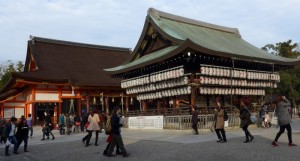November 28 – December 1: Kyoto & Nagoya
Day 2 (Friday): Good weather – Higashiyama, Eastern Kyoto
There are numerous temples at the foot of Mt. Higashiyama. Unlike Arashiyama, the Sennyuji Michi Street the path leading to Sennyuji Temple, is quiet with few visitors.
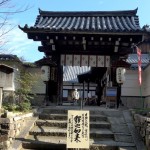 Sokujoin Temple 即宗院 is believed to date back to 992 when priest Eshin of Enryakuji Temple (Mt. Hiei) built Komyoin Temple in Fushimi in the south of Kyoto. During the second half of the 11th century, Toshitsuna Tachibana, son the Yorimihi Fujiwara, the highest ranked aristocrat in the imperial court of that time, moved the original temple into his villa and later changed the villa into a temple. I brought a ticket in order to go inside the Main Hall to take a closer look at the beautiful statute of Amida Buddha, a national treasure created in the late 11th century. Fukurokuku福禄寿, god of happiness, wealth and longevity is the deity enshrined in this temple.
Sokujoin Temple 即宗院 is believed to date back to 992 when priest Eshin of Enryakuji Temple (Mt. Hiei) built Komyoin Temple in Fushimi in the south of Kyoto. During the second half of the 11th century, Toshitsuna Tachibana, son the Yorimihi Fujiwara, the highest ranked aristocrat in the imperial court of that time, moved the original temple into his villa and later changed the villa into a temple. I brought a ticket in order to go inside the Main Hall to take a closer look at the beautiful statute of Amida Buddha, a national treasure created in the late 11th century. Fukurokuku福禄寿, god of happiness, wealth and longevity is the deity enshrined in this temple.
Imakumano-Kannonji Temple今熊野観音寺, the 15th temple on the Saigoku Kannon pilgrimage, is nested away in the forest. The foliage which just reached its peak was so gorgeous that I stopped to enjoy the colourful maple leaves for half an hour.
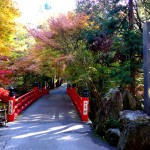 |
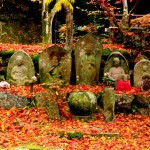 |
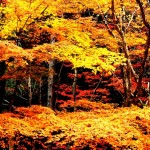 |
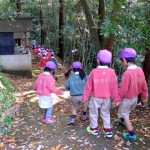 |
Three groups of kindergarten kids were on an outing. Despite their age, they climbed up the steep staircase with confidence and played under the flaming maple leaves. A girl fell and cried. Her teacher picked her up, held her hands and told her to walk on. Good training! In Hong Kong, parents tend to blame the school for everything and would likely accuse the teacher for negligence if their kid falls. Our kids are too spoilt.
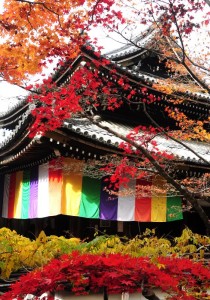 |
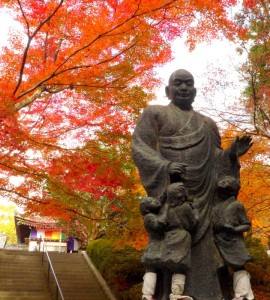 |
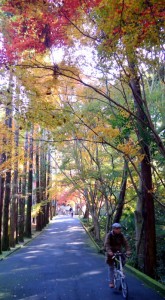 |
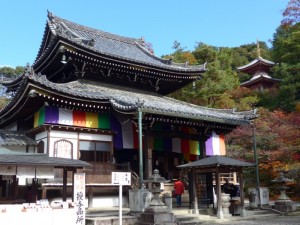 |
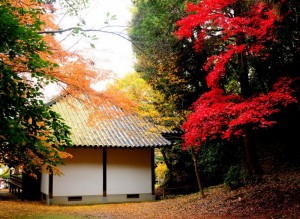 |
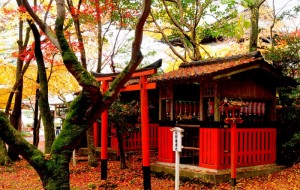 |
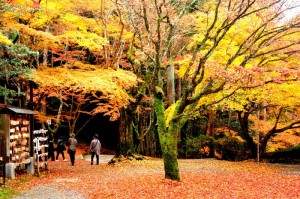 |
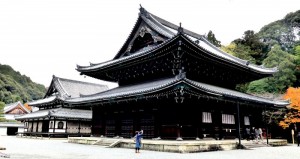 Sennyuji Temple founded in 1219 during the early Heian period by Gachirindaishi Shunjyo, was completed in 1226. Its origin can be traced back to the Tencho era (824-834) when Kukai (founder of Shingon Buddhism) established a small temple in this location. The temple got its name owing to the presence of a clear spring within the temple ground. For centuries, it was a mortuary temple for aristocrats and the imperial house. Located here are the official tombs of Emperor Shijo who reigned from 1231 to 1242 and many emperors who came after him.
Sennyuji Temple founded in 1219 during the early Heian period by Gachirindaishi Shunjyo, was completed in 1226. Its origin can be traced back to the Tencho era (824-834) when Kukai (founder of Shingon Buddhism) established a small temple in this location. The temple got its name owing to the presence of a clear spring within the temple ground. For centuries, it was a mortuary temple for aristocrats and the imperial house. Located here are the official tombs of Emperor Shijo who reigned from 1231 to 1242 and many emperors who came after him.
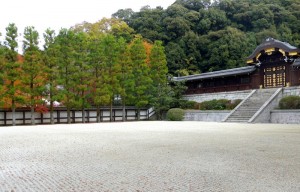 |
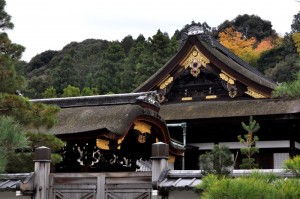 |
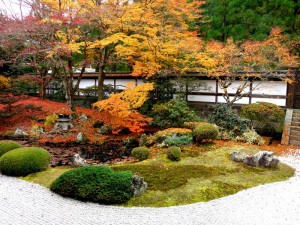 |
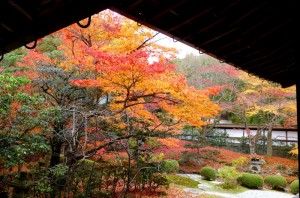 |
Before leaving the main building, I had a nice surprise and saw the Kanhikari Art Expo 2014, an art project which mission is to share and spread art and culture based on new values within the Japanese cultural heritage. The works of contemporary artists are displayed in Kyoto and Kamakura. The temple provides a nice setting for the exhibition!
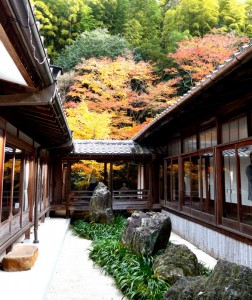 |
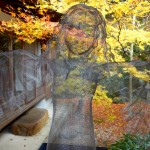 |
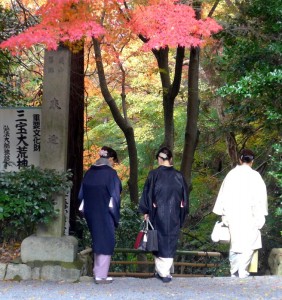 |
Unryuin Temple雲龍院established in 1372 by Emperor Gokogon, is a branch temple of Sennyuji Temple. The gardens and foliage seen through the artistic design of the windows and doors show the trees, stones and foliage at their best. There were few visitors. I sat on the tatami gazing at the garden, soaking in the atmosphere and appreciating the ‘Zen’ feel of the place.
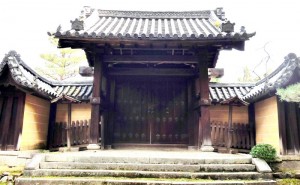 |
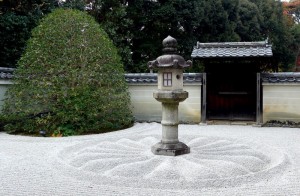 |
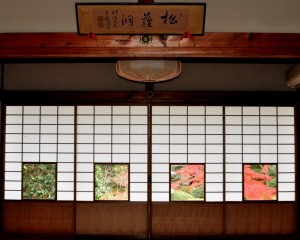 |
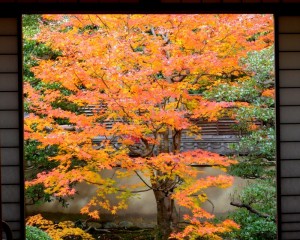 |
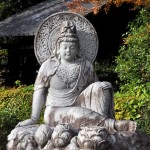 |
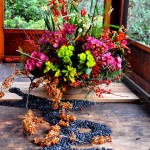 |
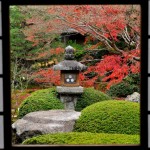 |
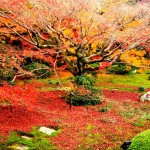 |
It was after 2:30pm when I boarded Bus No 100 to Nanzenji Temple南禅寺. I did not arrive at the temple till 4pm. There were over 30 coaches and hundreds of visitors: this was the most crowded attraction I visited during the entire trip.
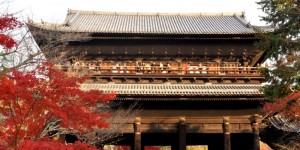 In 1264, Emperor Kameyama built the villa Zenrinjiden which became a Zen temple in 1291. The temple expanded in the Edo era, is a large complex with over half a dozen sub-temples. The current buildings were rebuilt during the Momoyama period (1570-1600). It is one of the Kyoto Gozan京都五山 along with Shokoku-ji 相国寺, Kennin-ji 建仁寺, Tofuku-ji 東福寺,, and Manju-ji 満寿寺, and and the head temple presiding over the Gozan.
In 1264, Emperor Kameyama built the villa Zenrinjiden which became a Zen temple in 1291. The temple expanded in the Edo era, is a large complex with over half a dozen sub-temples. The current buildings were rebuilt during the Momoyama period (1570-1600). It is one of the Kyoto Gozan京都五山 along with Shokoku-ji 相国寺, Kennin-ji 建仁寺, Tofuku-ji 東福寺,, and Manju-ji 満寿寺, and and the head temple presiding over the Gozan.
The Sanmon reconstructed in 1628 is majestic. But I had no time to buy a ticket and climb to the top. Instead, I headed to the hōjō (abbot’s quarters), the garden of which was built in the 1600s by Kobori Enshu. The garden mirroring natural forms, is seventy percent gravel. It is considered one of the most significant examples of kare-sansui (“dry landscape”) gardens and has been designated a national Place of Scenic Beauty. The garden lives up to its reputation. I was lucky to arrive just in time to catch the setting sunrays shining upon the flaming maple leaves.
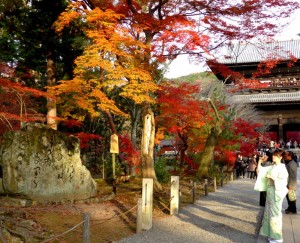 |
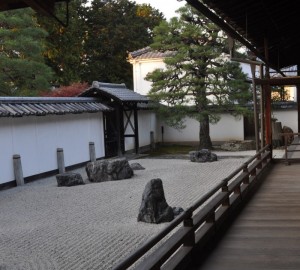 |
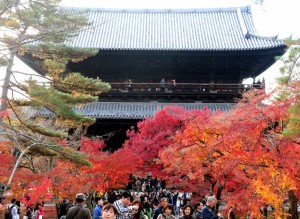 |
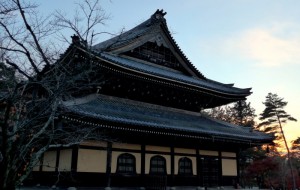 |
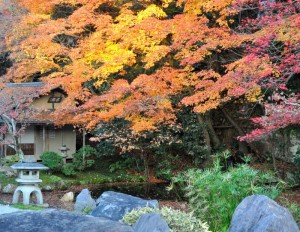 |
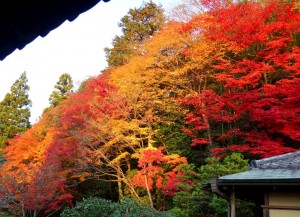 |
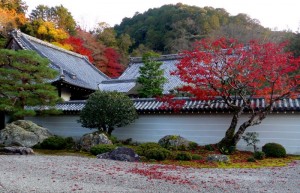 |
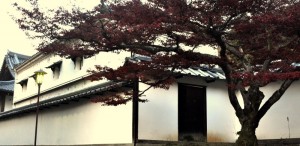 |
I intended to visit Eikan-do Zenrinji Temple 永観堂禅林寺 next to Nanzenji. But it was closed by the time I arrived. I could queue up for the night viewing. The Taiwanese couple told me that they had waited half an hour the night before. I was tired and decided to call it a day.
I had fried shrimp noodles in a local eatery near K’s House. A beer and the noodles cost ¥1,200. I either had an enormous appetite or was very hungry. I finally decided to return to the hostel with a half-empty stomach: I believe it is better for my health to go to bed without a full stomach.
Day 3 (Saturday): Rain & Sunshine
Today’s forecast was poor and I lost my stamina. I did not leave the hostel till 8:30am. The sky brightened up and the afternoon turned out to be beautiful and warm. Unfortunately, I wasted almost three hours on travelling and only visited three temples in the daytime.
Ninnaji Temple仁和寺was founded by the 59th Emperor Uda in the fourth year of Ninna (AD 888). It was formerly called the Old Imperial Palace of Omuro as it served as a residence for the ex-emperor. It is now the head temple of the Omuro school of Shingon sect of Buddhism. The Omuro School of Flower Arrangement is also housed here. After retiring from his throne, Emperor Uda became the first Monzeki, or aristocratic priest of the temple. From then to the late Edo period in 1869, the tradition was for reigning Emperors to send a son to the temple to take over as head priest when a vacancy arose.
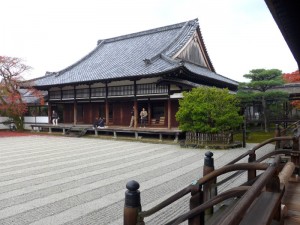 |
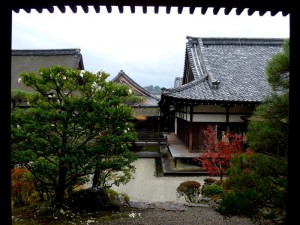 |
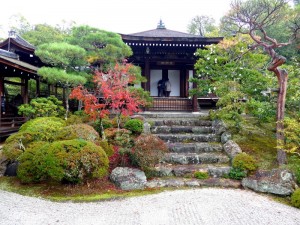 |
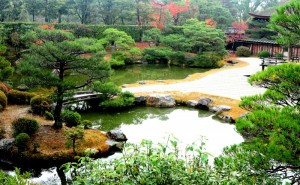 |
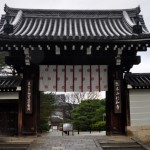 |
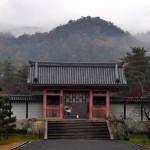 |
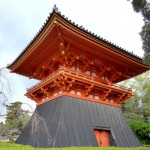 |
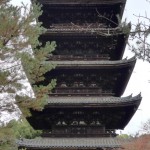 |
Most of the buildings in the temple today date from the 17th century. The Kondo and Miedo halls were moved from the Kyoto Imperial Palace and rebuilt here. By chance I visited the Kukai Hall which is under renovation. The uniquely low-branched cherry trees called Omuro Cherry is one of the treasures of the temple. Next to the Kondo (Main Hall) is a gigantic maple tree with red-purple leaves which attracted keen photographers to take photos of the leaves from different angles.
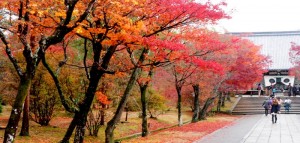 |
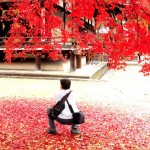 |
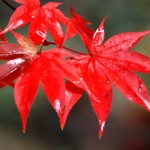 |
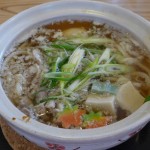 My next stop was Ryoanji Temple龍安寺, ten minutes’ walk from Ninnaji. On my way, I passed a small café advertising home-made buckwheat noodles. It’s about 11:45am. I decided to go in for an early lunch. The chef is a young lady and the café has only 12 seats. The simple and cozy decoration together with soft classical music create a soothing atmosphere. I ordered a duck-hot-pot noodle lunch set for ¥1,000. It’s most delicious with aroma from the fresh vegetables and duck. Japanese like coffee and I finished my lunch with a cup of coffee with cream. When I came out, I was surprised to be greeted by blue sky and sunshine.
My next stop was Ryoanji Temple龍安寺, ten minutes’ walk from Ninnaji. On my way, I passed a small café advertising home-made buckwheat noodles. It’s about 11:45am. I decided to go in for an early lunch. The chef is a young lady and the café has only 12 seats. The simple and cozy decoration together with soft classical music create a soothing atmosphere. I ordered a duck-hot-pot noodle lunch set for ¥1,000. It’s most delicious with aroma from the fresh vegetables and duck. Japanese like coffee and I finished my lunch with a cup of coffee with cream. When I came out, I was surprised to be greeted by blue sky and sunshine.
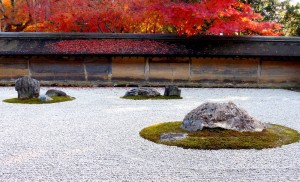 Ryoanji Temple (Temple of the Dragon at Peace), a Zen temple built in the 15th century, is world famous for its rock garden considered one of the finest surviving examples of kare-sansui . I did not want to follow the crowd and took a side path where I saw beautiful sunbeams coming through. This path turns out to be the one going round the Kyoyochi Pond (water garden). Hence, I walked in a counter-clockwise way and had a wonderful experience of walking under the most colourful canopy of maple trees in perfect sunlight. The colours and setting with the temple, tea house, low-lying hills and ducks in the pond is like a picture. This’s the pond walk is the highlight of the day!
Ryoanji Temple (Temple of the Dragon at Peace), a Zen temple built in the 15th century, is world famous for its rock garden considered one of the finest surviving examples of kare-sansui . I did not want to follow the crowd and took a side path where I saw beautiful sunbeams coming through. This path turns out to be the one going round the Kyoyochi Pond (water garden). Hence, I walked in a counter-clockwise way and had a wonderful experience of walking under the most colourful canopy of maple trees in perfect sunlight. The colours and setting with the temple, tea house, low-lying hills and ducks in the pond is like a picture. This’s the pond walk is the highlight of the day!
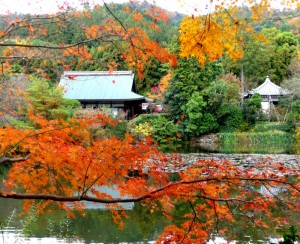 |
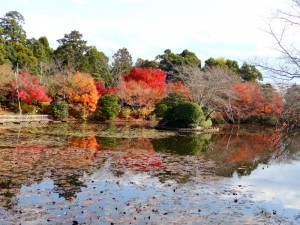 |
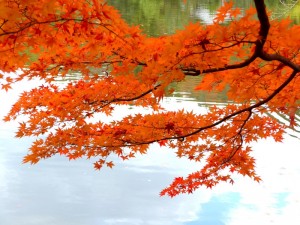 |
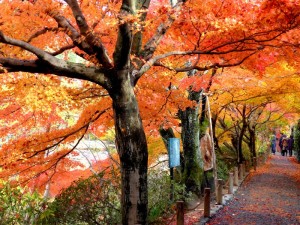 |
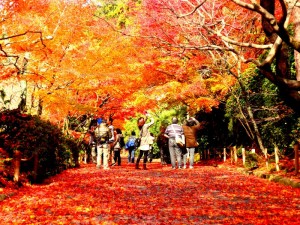 |
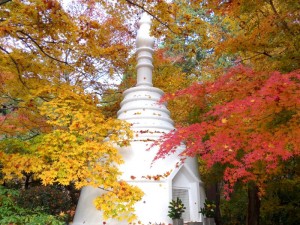 |
I finally found my way to the main hall. The garden was full of busy tourists who tried to find all the 15 pieces of the rock. I remember my first visit here when I could sit quietly to appreciate and soak in the Zen atmosphere. Today, my mood was ruined by the noisy crowd.
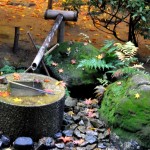 |
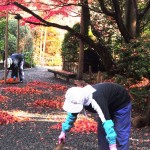 |
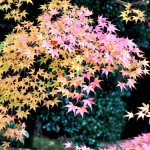 |
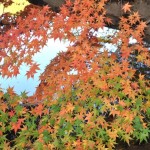 |
It was not yet 3pm when I made my way to Eikan-do Zenrin-ji Temple 永観堂禅林寺. I had to change in town for Bus No 5. The bus was full but many tourists still tried to get on. As a result, the bus moved slowly and wasted a lot of time at each stop. By the time I arrived at the temple, it was already 4pm. The staff were kind and let a huge crowd in before closing the gate.
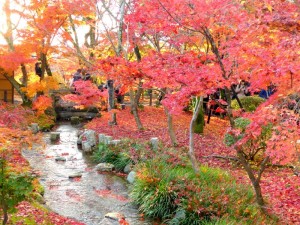 |
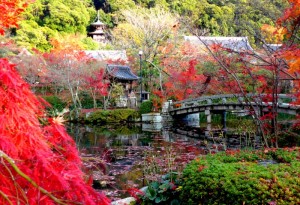 |
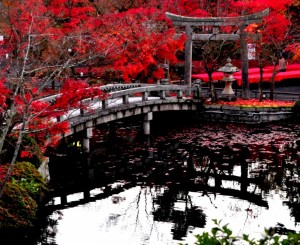 |
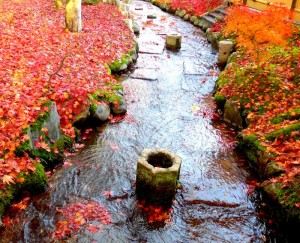 |
The small temple ground was jammed packed with tourists. The sun was setting and I saw the magical soft sunbeams falling on the leaves. I only managed to take a few pictures before it got too dark. I walked up the slope to reach the pagoda. It was too dim for a good panoramic view of Kyoto. The temple complex was closed and I had no chance to go inside. What a shame! I could have paid ¥200 less and come in for night viewing.
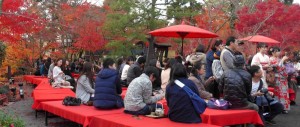 |
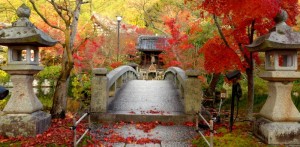 |
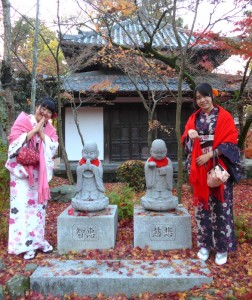 |
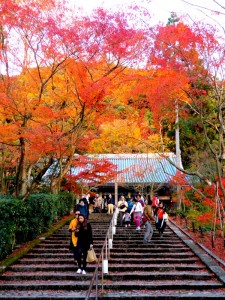 |
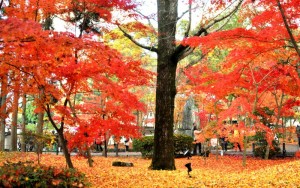 |
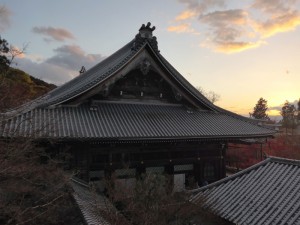 |
I had a sashimi set dinner for ¥2,700 before taking Bus 100 to Gion祇園and Yasaka shrine八坂神社 which hosts the famous annual Gion Matsuri when the mikoshi (divine palanquin) of Gion Shrine were paraded through the streets of Kyoto. I like the atmosphere of old kyoto with narrow lanes in stones. Then I found myself in front of a long queue waiting for night viewing at Kodaiji Temple高台寺.I was in a good mood and did not mind joining the queue.
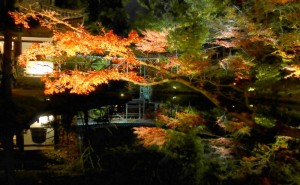 The temple was established in 1605 by Kita-no-Mandokoro in memory of her late husband, Toyotomi Hideyoshi (1536-98). Tokugawa Ieyasu, Hideyoshi‘s chief vassal who later became Shogun of Japan financed the construction of this temple which is renowned for its beautiful design and exquisite craftsmanship. In 1624, Sanko Jochi, Abbot of Kenninji Temple 建仁寺was appointed the founding priest. Hence, this temple has remained one of the Kenninji Temple’s largest and most important sub-temples ever since.
The temple was established in 1605 by Kita-no-Mandokoro in memory of her late husband, Toyotomi Hideyoshi (1536-98). Tokugawa Ieyasu, Hideyoshi‘s chief vassal who later became Shogun of Japan financed the construction of this temple which is renowned for its beautiful design and exquisite craftsmanship. In 1624, Sanko Jochi, Abbot of Kenninji Temple 建仁寺was appointed the founding priest. Hence, this temple has remained one of the Kenninji Temple’s largest and most important sub-temples ever since.
I queued for 20 minutes and got a combined ticket for three locations (Kodaiji Temple, Entoku-in Temple and Kodaiji Sho Museum) for ¥900. The lights were dim and I followed the crowd. Inside the main buildings, there were many rooms with paintings and I recognise with portraits of Toyotomi Hideyoshi and Kita-no-Mandokoro. The garden has been turned into an art installation with umbrellas in red, beige and purple colours with illumination. Then I found myself in another garden with a view of the beautifully illuminated Kangetsu-dai (Moon Vewing Pavilion), Kaisan-do (Founder’s Hall) and the Garyoro (Reclining Dragon Corridor) as well as their reflections in the pond.
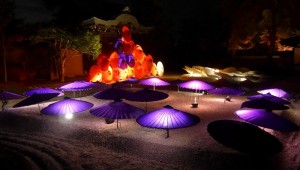 I followed a path uphill passing by the Kasa-Tei and Shigure-Tei, both had umbrellas with illumination inside. Then there were more illuminated umbrellas spreading out in a bamboo forest next to the downhill path. Though I did not seen much, the illumination and art installation create a unique and beautiful feel about the place.
I followed a path uphill passing by the Kasa-Tei and Shigure-Tei, both had umbrellas with illumination inside. Then there were more illuminated umbrellas spreading out in a bamboo forest next to the downhill path. Though I did not seen much, the illumination and art installation create a unique and beautiful feel about the place.
I was lucky with the weather which had improved in the afternoon. I had a day full of nice surprises.
Day 4 (Sunday): Nice warm day- Higashiyama, Eastern Kyoto
Before leaving by bus for Nagoya at 5:30pm, I spent my remaining time in Kyoto in the Higashiyama district visiting two temples and a museum, walking and having a nice simple lunch.
Kiyomizu Temple清水寺, founded in 789 is a popular tourist spot. The present buildings were constructed in 1633 on the order of Tokugawa Ietimsu. The main hall has a large veranda supported by tall pillars that juts out over the hillside and offers a panoramic view of the city and surrounding areas. No nail is used in the entire structure.
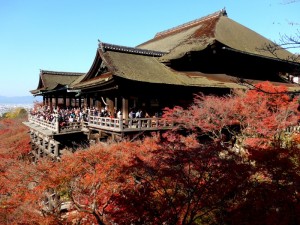 |
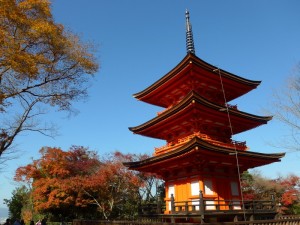 |
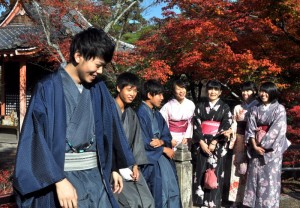 |
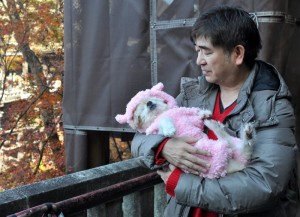 |
A couple of buildings have been covered up for renovation. The foliage had already peaked and the colours were dull and many branches were bare. I find the whole place too crowded and noisy.
There is an exit near the pagoda with signs to another temple. I followed the path and soon discovered signs on the Higashiyama Trail. I decided to follow the trail: I could exit to go to the Kodaiji Temple or Maruyama Park. The trail was covered with fallen leaves and quiet. For the first part of the walk (about an hour), I had only met a young jogger and two elderly hikers. Then instead of taking the main trail, I mistakenly followed a side path next to a water catchment area. The path is slippery and very narrow. I was a bit scared. But I am sure the downhill path next to a water catchment area will take me to somewhere between the Kiyomizu Temple and Maruyama Park. I was right: I arrived at the Higashi-Otani cemetery near the Kodaiji Temple.
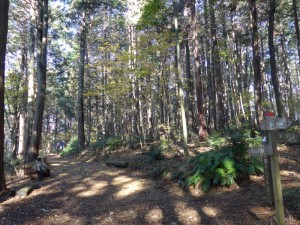 |
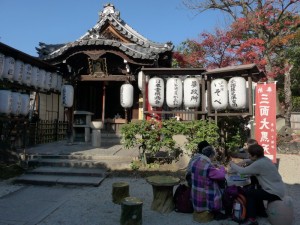 |
I spent the next three hours strolling aimlessly in old Kyoto at the foot hill of Mt. Higashiyama. I walked past the Maruyama Park before arriving at the Yasaka Shrine八坂神社. The whole area is lively with locals and Japanese visitors. There were many food street stalls and many ladies in kimono were posing for photos.
With the combined ticket, I visited the Entoku-in Temple圓徳院and Kodaiji Sho Museum. The former built in 1605 was the home of Kita-no-Mandokoro after the death of her husband. It has an elegant Momoyam style garden. The latter is a museum with exhibits from the family.
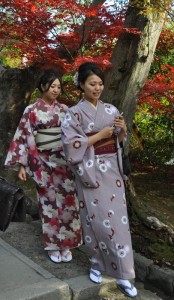 |
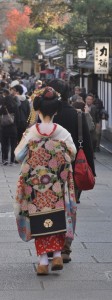 |
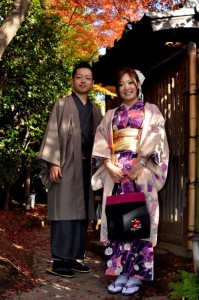 |
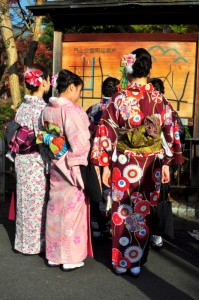 |
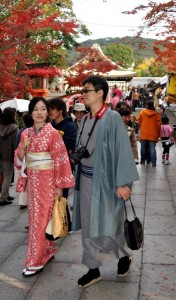 |
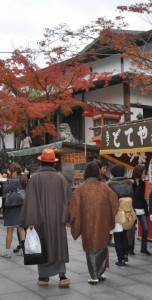 |
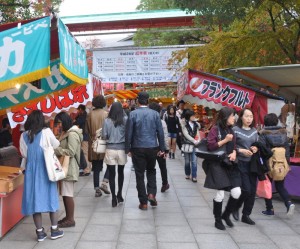 |
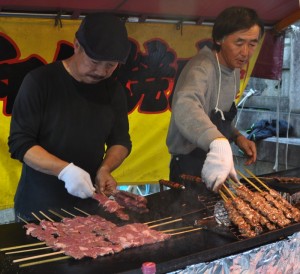 |
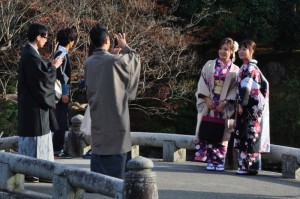 |
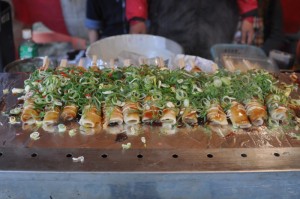 |
I spotted an old house-café in a side street. Guests sitting around the open kitchen table enjoy the garden view while eating and drinking. The ambience is excellent and cozy. I had a spaghetti for ¥900.
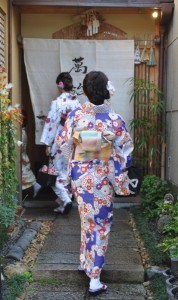 |
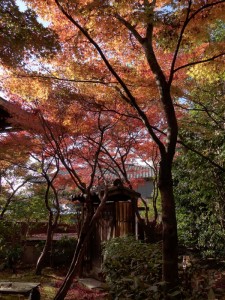 |
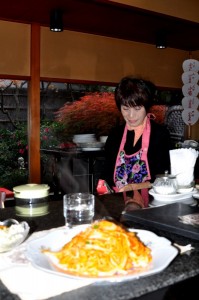 |
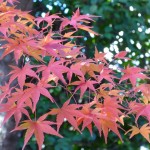 |
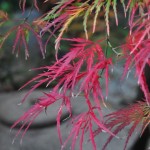 |
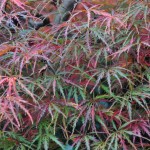 |
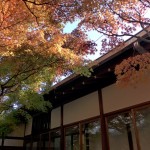 |
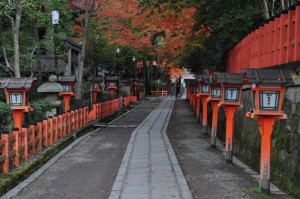 |
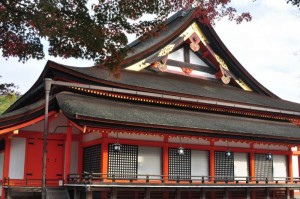 |
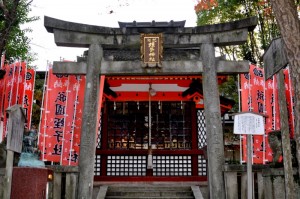 |
|
The bus fare to Nagoya is ¥2,500. I was told it would take two and a half hours. It started to rain and the traffic was bad. At the end, I did not arrive at the Nagoya Station till 8:45pm. The Shinkansen may cost over ¥5,000 but only takes half an hour. In future, I would rather pay more and save time.
I stayed at Toyoku-Inn again. As I turned on the hot water tap and forgot to have the toilet fan on, steam streaming out into the room set off the fire alarm. The receptionist called me to see whether there was a fire! I was embarrassed!
December 1 Monday: Nagoya (GMT+9) – Hong Kong (GMT+8)
I must be tired and did not open my eyes till 9am! I rushed to take breakfast before 9:30am. The weather was bad and cold. I checked out at 10am and went for sight-seeing for two hours with a metro day pass for ¥740.
Armed with an umbrella, I went to the 1000-year-old Atsuta Shrine, Japan’s second largest shrine. There were not many visitors. But I saw five children dressed up in traditional costumes with special candy package in their hands.
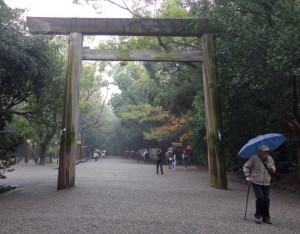 |
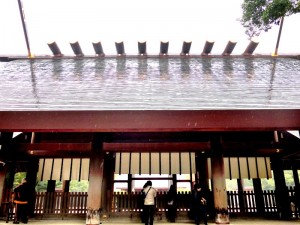 |
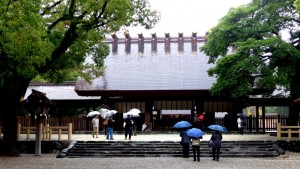 |
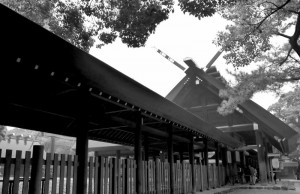 |
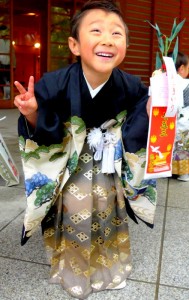 |
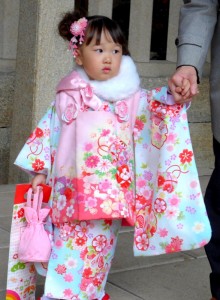 |
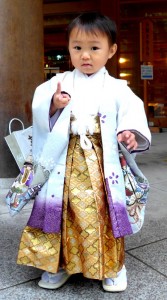 |
My next destination was Osu Kannon Temple. My original plan was to go to and eat in the Shike-Michi District which is said to retain the feel from the 1600’s and the old castle town of Nagoya. On the way to the metro station, I passed by a shopping area next to the temple where I spent over an hour doing Christmas shopping and having a most delicious pork noodle soup.
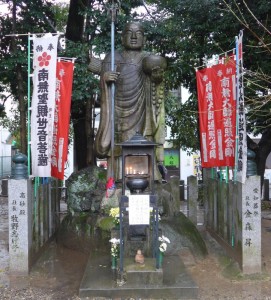 |
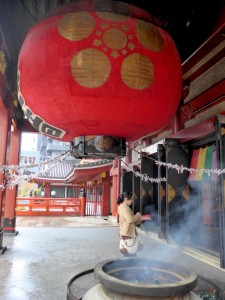 |
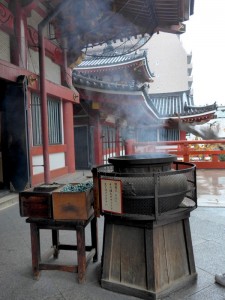 |
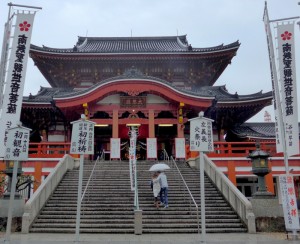 |
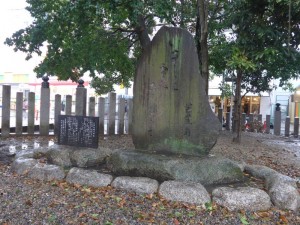 |
At 2:30pm, I boarded the train for the airport. My plane departed around 5:30pm and took four hours to fly to Hong Kong. I was home at 10:30pm.
Remarks
I had a most enjoyable break in Japan, thanks to the stunningly beautiful foliage and Miyo’s hospitality. I made this trip with a viewing to seeing foliage while hiking and in Kyoto. I ended up having a wonderful 3-day hike from Narai to Tsumago with some wonderful rural scenery and fall colours along the Nakasendō. The foliage in Kyoto is most impressive and unearthly beautiful living up to its reputation.
I simply cannot believe how colourful and beautiful leaves can be! Foliage colours are vibrant and breathtaking. I have spent five wonderful days in Kyoto visiting a dozen temples with most stunning colours and settings. But there is still so much to see: I shall definitely return for the fall colours.
It is the first time for me to stay with a friend in Japan. The experience is totally different from staying in a minshuku. Miyo and her husband who have lived briefly in Toronto are westernised, friendly and most wonderful. We had a fun time talking, dining and drinking! I hope I would be able to make a trip to Mt. Fuji with Miyo one day. This will probably be the purpose of next trip to Japan


